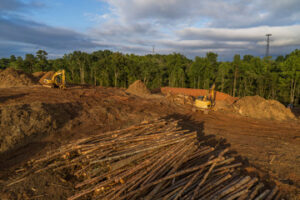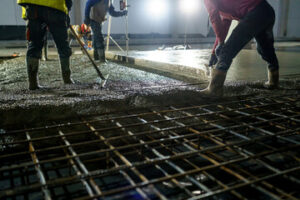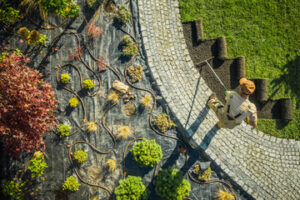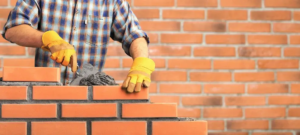Land Clearing is the first step in property development projects like building homes or expanding agricultural operations. It clears obstacles and reveals the property’s potential by removing trees, stumps, brush and other debris.

Choosing the right clearing method depends on local permits, environmental regulations and project goals. Our crews can help you decide the best process for your site.
If you plan to develop your land, whether for construction purposes or for recreational activities, you’ll need to have good access to it. The best way to do this is by hiring professional commercial land clearing services. These services remove unwanted trees, dense underbrush, and other debris to improve site accessibility. This allows vehicles and equipment to move through the area without any issues, reducing risks of accidents and ensuring that work can be done safely and efficiently.
In addition to increasing the usability of your property, land clearing can also enhance its aesthetics. Clearing away the clutter of bushes, vines, and other plants creates an open, inviting space that is visually appealing. It also gives you a blank canvas to design and implement landscaping features, such as gardens and outdoor living spaces.
Another advantage of land clearing is that it can help prevent soil erosion by removing the overgrowth of vegetation. This is particularly important for land that will be used for agriculture or other human activities, as overgrowth can lead to runoff and loss of nutrients. Land clearing can also help control pest infestations by reducing the hiding spots for unwanted insects and wildlife.
While the benefits of land clearing are numerous, it is crucial that you choose a method that preserves as much of the natural ecosystem as possible. Avoid using methods that can cause significant environmental damage, such as slash and burn or clear-cutting. Instead, opt for land clearing processes that use advanced technology to ensure minimal impact on the environment. These techniques also minimize the amount of waste that needs to be disposed of, which is often a challenge in rural areas.
Aesthetics
Whether you are clearing a property for construction, landscaping, or other land use, the aesthetics of your landscape is important. Proper land clearing can enhance your property’s curb appeal by improving visibility and sightlines. Overgrown trees, shrubs, and grass can obscure views and create tripping hazards for vehicles and pedestrians. Land clearing allows for clearer lines of sight, making it easier to navigate your property and reduces safety risks.
Cleared land provides a blank canvas for projects like building foundations, roads, and utility lines. When conducted properly, it can also promote healthier vegetation growth in the cleared area.
Overgrown trees and brush harbor diseases that are difficult to detect. Regular land clearing removes infected plant material and helps maintain healthy soil, enhancing the overall health of your land.
Selective clearing can reveal breathtaking vistas and highlight architectural features, elevating your property’s visual appeal. In addition, removing invasive plants and promoting the growth of native species can help restore wildlife habitats.
Land clearing releases greenhouse gases, but it can also improve the climate by regulating rainfall and altering the movement of heat and moisture. This is especially important in agriculture, as clearing vegetation allows for better crop growth by allowing sunlight and water to penetrate the soil. In addition, the removal of dense foliage improves soil quality by reducing compaction and nutrient depletion, while creating space for new growth. Using methods like mulching can further enhance soil health by adding organic material and improving its water retention capabilities. By engaging the public in transparent communication about the purpose and processes of land clearing, we can dispel misconceptions and encourage positive environmental impacts. This can be accomplished through workshops, educational materials, and community meetings.
Safety
Whether you are clearing land to build on or improve your home or commercial property, the safety of those using your site is of paramount concern. This includes both visitors and workers. Overgrown trees, bushes, and other plants can create tripping hazards, as well as block pathways.
In addition, rotting branches and tree stumps pose a fire hazard and can fall during stormy weather, potentially injuring or damaging people or structures. Additionally, pollen from overgrown plants can affect air quality and make it difficult for people with allergies to breathe easily. Land Clearing removes these hazards and ensures that your property is safe for all to enjoy.
When performing land clearing, it is important to use proper equipment for the job. Doing so can protect the environment and reduce the risk of machinery malfunctions, operator injury, or environmental damage. For example, a bulldozer or excavator equipped with a specialized forestry mulcher is designed to uproot trees, grind stumps, and remove thick underbrush quickly and efficiently, while providing stability and control for the operator.
Proper Land Clearing also involves implementing erosion control measures, such as silt fences and ponds, to prevent soil erosion, sediment runoff, and environmental damage. This is essential to ensuring that your project is completed in a manner that meets all local and state regulations.
Finally, proper land clearing requires a team of trained professionals. This means wearing the right safety equipment and following all safety guidelines to prevent injuries or equipment malfunctions. It also involves a thorough inspection of all machinery prior to and during operation, as well as regular maintenance. Trying to do land clearing on your own can result in accidents and injuries, as well as expensive repairs or replacements.
Health
The process of clearing land involves removing trees, shrubs, and other vegetation. This step typically prepares a site for construction by creating an open space. It also removes debris like rocks and tree stumps. Once the site is cleared, it can be graded to create a smooth surface for building. Land clearing is an important part of many construction projects, including residential development, septic systems, and commercial developments. It is often performed by trained professionals who use specialized equipment like excavators and bulldozers.
One of the benefits of land clearing is that it promotes healthy growth of plants and trees. A plot crowded with vegetation makes it difficult for plants to get enough water and sunlight. Clearing land gives plants more room to thrive and cultivate healthy levels of soil nutrients.
Clearing land also prevents soil erosion. Overgrown plants and weeds can pull soil down, which can damage buildings or other structures. Professionals who perform land clearing can use techniques like mulching, contour plowing, and other soil conservation methods to minimize the effects of the clearing process on the surrounding environment.
Additionally, clearing land can help reduce the risk of pest infestations. Overgrown plants and weeds provide a perfect habitat for mosquitoes, flies, and other insects. In addition, rotting wood and dead plants attract termites and other unwanted pests. Land clearing removes the food sources of these pests and reduces their numbers, which helps to protect people and animals that live in or near the area.
Clearing land has a big impact on wildlife habitats. When animals lose their natural habitat, they may need to travel further for food or shelter. This can cause them to come into contact with humans, increasing the risk of disease. In addition, logging and cattle ranching often destroys rainforest ecosystems and habitats for orangutans and other endangered species.
Property Value
When a property is covered in trees, brush, and other overgrowth, it can be difficult to access or work on. Having the land cleared allows construction crews to get to the site and carry out projects without delay or obstacles. This minimizes delays and saves money for the project’s owners.
Cleared land can also improve your property’s value. Overgrown land is less attractive to potential buyers, as it doesn’t offer the same visual appeal as a well-maintained plot of land. This is especially true for agricultural or commercial properties. Cleared land also reveals the true size and potential of a property, making it easier for investors to envision their potential development projects on that site.
Land clearing can help reduce fire risks for property owners by removing combustible materials and creating defensible space around buildings. This is especially important in fire-prone areas, but it can be a good precaution for any property owner.
Overgrown flora can also harbour pests and disease that threaten the health of other plants on the property. Land clearing removes these elements and promotes healthier growth by allowing other vegetation to flourish in the sun.
If you’re looking to make the most out of your property, professional Land Clearing is a must. It helps you overcome obstacles and unlock the full potential of your property for landscaping, infrastructure projects, agriculture, or anything else. To learn more about how our services can benefit your property, contact us today. We look forward to helping you transform your vision into reality!








